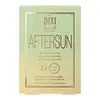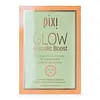What's inside
What's inside
 Key Ingredients
Key Ingredients

 Benefits
Benefits

 Concerns
Concerns

No concerns
 Ingredients Side-by-side
Ingredients Side-by-side

Water
Skin ConditioningGlycerin
HumectantBetaine
HumectantNiacinamide
SmoothingPanthenol
Skin ConditioningTremella Fuciformis Extract
HumectantAllantoin
Skin ConditioningAscorbic Acid
AntioxidantCucumis Sativus Fruit Extract
EmollientChamomilla Recutita Extract
Skin ConditioningAloe Barbadensis Leaf Extract
EmollientPhellinus Linteus Extract
Skin ConditioningChamomilla Recutita Flower Extract
MaskingArctium Lappa Root Extract
Skin ConditioningMadecassoside
AntioxidantCeramide NP
Skin Conditioning1,2-Hexanediol
Skin ConditioningDipotassium Glycyrrhizate
HumectantOctyldodecanol
EmollientTrehalose
HumectantHydrogenated Lecithin
EmulsifyingEthyl Hexanediol
SolventHydroxyethylcellulose
Emulsion StabilisingCaprylyl Glycol
EmollientPhenoxyethanol
PreservativeWater, Glycerin, Betaine, Niacinamide, Panthenol, Tremella Fuciformis Extract, Allantoin, Ascorbic Acid, Cucumis Sativus Fruit Extract, Chamomilla Recutita Extract, Aloe Barbadensis Leaf Extract, Phellinus Linteus Extract, Chamomilla Recutita Flower Extract, Arctium Lappa Root Extract, Madecassoside, Ceramide NP, 1,2-Hexanediol, Dipotassium Glycyrrhizate, Octyldodecanol, Trehalose, Hydrogenated Lecithin, Ethyl Hexanediol, Hydroxyethylcellulose, Caprylyl Glycol, Phenoxyethanol
Water
Skin ConditioningDipropylene Glycol
HumectantGlycerin
HumectantGlycolic Acid
BufferingPanax Ginseng Root Extract
EmollientAloe Arborescens Leaf Extract
MoisturisingPanax Ginseng Callus Culture Extract
Skin ConditioningCamellia Sinensis Leaf Extract
AntimicrobialCucumis Sativus Extract
Skin ConditioningCastanea Sativa Seed Extract
Skin ConditioningDioscorea Japonica Root Extract
Skin ConditioningOcimum Basilicum Seed Extract
AntioxidantHamamelis Virginiana Extract
AntiseborrhoeicMorus Alba Bark Extract
Skin ConditioningAsiaticoside
AntioxidantCoix Lacryma-Jobi Ma-Yuen Seed Extract
Skin ConditioningIllicium Verum Fruit Extract
PerfumingTrehalose
HumectantCeramide AP
Skin Conditioning1,2-Hexanediol
Skin ConditioningPropanediol
SolventCaprylyl Glycol
EmollientEthylhexylglycerin
Skin ConditioningPotassium Hydroxide
BufferingXanthan Gum
EmulsifyingButylene Glycol
HumectantDisodium EDTA
Water, Dipropylene Glycol, Glycerin, Glycolic Acid, Panax Ginseng Root Extract, Aloe Arborescens Leaf Extract, Panax Ginseng Callus Culture Extract, Camellia Sinensis Leaf Extract, Cucumis Sativus Extract, Castanea Sativa Seed Extract, Dioscorea Japonica Root Extract, Ocimum Basilicum Seed Extract, Hamamelis Virginiana Extract, Morus Alba Bark Extract, Asiaticoside, Coix Lacryma-Jobi Ma-Yuen Seed Extract, Illicium Verum Fruit Extract, Trehalose, Ceramide AP, 1,2-Hexanediol, Propanediol, Caprylyl Glycol, Ethylhexylglycerin, Potassium Hydroxide, Xanthan Gum, Butylene Glycol, Disodium EDTA
Ingredients Explained
These ingredients are found in both products.
Ingredients higher up in an ingredient list are typically present in a larger amount.
1,2-Hexanediol is a synthetic liquid and another multi-functional powerhouse.
It is a:
- Humectant, drawing moisture into the skin
- Emollient, helping to soften skin
- Solvent, dispersing and stabilizing formulas
- Preservative booster, enhancing the antimicrobial activity of other preservatives
Caprylyl Glycol is a humectant and emollient, meaning it attracts and preserves moisture.
It is a common ingredient in many products, especially those designed to hydrate skin. The primary benefits are retaining moisture, skin softening, and promoting a healthy skin barrier.
Though Caprylyl Glycol is an alcohol derived from fatty acids, it is not the kind that can dry out skin.
This ingredient is also used as a preservative to extend the life of products. It has slight antimicrobial properties.
Learn more about Caprylyl GlycolGlycerin is already naturally found in your skin. It helps moisturize and protect your skin.
A study from 2016 found glycerin to be more effective as a humectant than AHAs and hyaluronic acid.
As a humectant, it helps the skin stay hydrated by pulling moisture to your skin. The low molecular weight of glycerin allows it to pull moisture into the deeper layers of your skin.
Hydrated skin improves your skin barrier; Your skin barrier helps protect against irritants and bacteria.
Glycerin has also been found to have antimicrobial and antiviral properties. Due to these properties, glycerin is often used in wound and burn treatments.
In cosmetics, glycerin is usually derived from plants such as soybean or palm. However, it can also be sourced from animals, such as tallow or animal fat.
This ingredient is organic, colorless, odorless, and non-toxic.
Glycerin is the name for this ingredient in American English. British English uses Glycerol/Glycerine.
Learn more about GlycerinTrehalose is a disaccharide made of two glucose molecules (glucose is sugar!). Trehalose is used to help moisturize skin. It also has antioxidant properties.
As a humectant, trehalose helps draw moisture from the air to your skin. This helps keep your skin hydrated.
Due to its antioxidant properties, trehalose may help with signs of aging. Antioxidants help fight free-radical molecules, unstable molecules that may damage your skin.
In medicine, trehalose and hyaluronic acid are used to help treat dry eyes.
Some animals, plants, and bacteria create trehalose as a source of energy to survive freeze or lack of water.
Learn more about TrehaloseWater. It's the most common cosmetic ingredient of all. You'll usually see it at the top of ingredient lists, meaning that it makes up the largest part of the product.
So why is it so popular? Water most often acts as a solvent - this means that it helps dissolve other ingredients into the formulation.
You'll also recognize water as that liquid we all need to stay alive. If you see this, drink a glass of water. Stay hydrated!
Learn more about Water